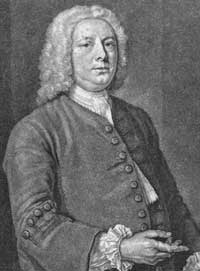William Caslon
| William Caslon | |
|---|---|

William Caslon I in an engraved portrait by John Faber the Younger
|
|
| Born | 1693 Cradley, Worcestershire |
| Died | 23 January 1766 (aged 72–73) London, England |
| Occupation | Gunsmith and type designer |
William Caslon I (1692/1693 – 23 January 1766), also known as William Caslon the Elder, was an English typefounder. The distinction and legibility of his type secured him the patronage of the leading printers of the day in England and on the continent. His typefaces transformed English type design and first established an English national typographic style.
Caslon was born in Cradley, Worcestershire in 1692 or 1693 and trained as an engraver in nearby Birmingham. In 1716, he started business in London as an engraver of gun locks and barrels and as a bookbinder's tool cutter. Having contact with printers, he was induced to fit up a type foundry, largely through the encouragement of William Bowyer.
He died on 23 January 1766, and was buried in the churchyard of St Luke Old Street, London, where the family tomb is preserved (bearing his name and others).
Though his name would come to be identified with an enduring style of Latin alphabet, Caslon's first typefaces were what contemporary typefounders called "exotics." His first design was an Arabic made at the English size (14pt), commissioned by the Society for Promoting Christian Knowledge before 1725, followed by a Hebrew created for William Bowyer in 1726, and a Coptic for Wilkins first used in 1731. His first Latin typefaces were a roman and italic cut in the pica size (12pt), of a style that was fully realized by the publication of his foundry's specimen sheet in 1734.
Caslon's typefaces were inspired by the Dutch Baroque types, the most commonly used types in England before Caslon's faces. His designs influenced John Baskerville and are thus the progenitors of the transitional and Didone typeface classifications.
...
Wikipedia
